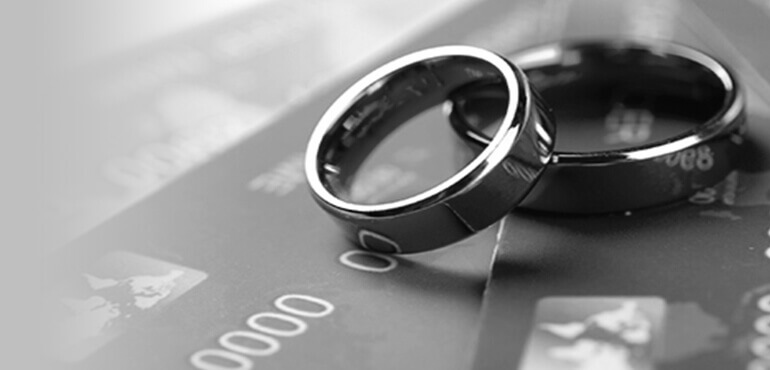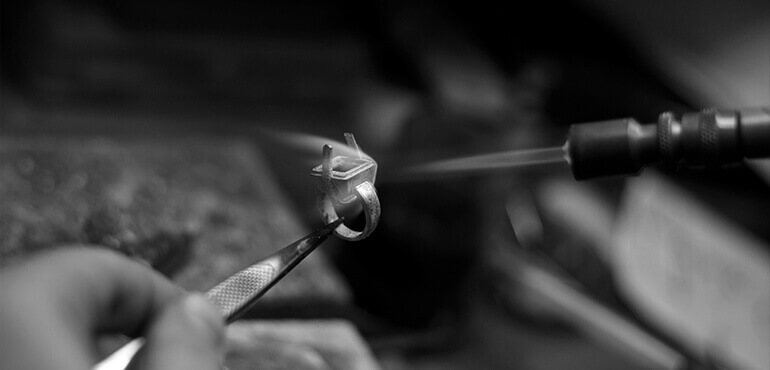Diamond Education Carat

At A Glance
- Carat weight describes the specific weight of a diamond, but alone may not accurately depict how large the diamond appears to be
- We primarily evaluate the size of a diamond based on viewing it from the top, because that is the part most visible when set in a ring
- Larger diamonds are more rare, thus are more expensive per carat
- To fully understand what size a diamond will appear to be once set in a ring, one must consider two other characteristics along with carat weight:
- The diamonds cut grade
- The distance in millimeters across the top of the diamond
What is Carat Weight?
When shopping for a diamond, one of the first characteristics you'll see in its description is the carat weight. A metric carat is the unit used when measuring a diamond's weight, with each carat being equivalent to 200 milligrams or 0.02 grams. (It's important not to confuse carat with karat, as in "18k gold", which is used to describe the purity of gold.)

A carat is divided into 100 points, similar to the way a dollar is divided into 100 pennies. Hence, a 75 point diamond weighs 0.75 carats. Yet, two diamonds of equal weight can have very different values due to their grades in the other 4C's. So, depending on your setting and your price range, you can choose a larger diamond in carat weight that's still in your budget if it has lower clarity or color grades.
Most diamonds used in fine jewelry weigh one carat or less, but even a fraction of a carat can make a considerable difference in price. Precision is vital within the diamond industry, so the weight is often measured to the hundred thousandths of a carat and then rounded to the nearest hundredth of a carat. Diamonds that have a carat weight greater than one carat are expressed in carats and decimals; such as a 1.09 ct diamond would be described as "one point oh nine carats".
Larger diamonds are rarer than smaller diamonds due to the diamond formation process. Since it only occurs in extremely rare circumstances and typically the natural materials required to create a diamond are only found in small amounts, larger diamonds are unusual. Due to this, large diamonds have a greater cost per carat and consequently the price of these diamonds rises exponentially. For instance, a 2-carat diamond will cost much more per carat than a 1-carat diamond of equal grade.
The carat weight of a diamond is an important feature in determining its size. Nonetheless, the carat weight alone may not accurately reflect the diamond's size or how large it actually appears. When considering the precise size of a diamond, you need to take note of two other factors that greatly influence the appearance of the diamonds size: 1.) the diamond's cut grade and 2.) the distance in millimeters across the top of the diamond.
As the most visible part of the diamond once set in a ring, the top of the diamond is the part you will be admiring the most and is a key characteristic in determining how large the diamond will appear. So, while taking into account the carat weight, be sure to pay attention to the exact length across the top of the diamond as well.
The chart below illustrates how different carat weights appear once set in a ring.
choose a diamond size

The cut grade of a diamond is crucial in how large it appears to be, because when a diamond is cut with the proper proportions it permits the maximum amount of light to return out of the top of the diamond; commonly referred to as sparkle. A well cut diamond will appear larger from the amount of light that is reflected out of the top of the diamond. Consequently, when a diamond is poorly cut it can appear much smaller than its carat weight would suggest, for instance, when much of its weight can be "hidden" in the base of the diamond. Thus, it is feasible to have a diamond of lower carat weight, but higher cut grade appear larger than a diamond with a higher carat weight and poor cut grade.

What Carat Weight is Right For Me?
Diamond Carat Size Chart
To acquire a better idea of how your diamond will appear once placed in its setting, view this chart that illustrates how diamonds of different carat weights and shapes will appear when viewed from the top down.
Your diamond may differ from the printout in length/width ratio, table, and depth.
view the carat chartWhen deciding what carat weight of diamond is best for you, you should consider the size of her finger, the size of your setting, and, of course, your budget. All of these factors greatly impact what carat weight is suitable, as well as even alter what carat weight is feasible. For instance, not all settings will fit all diamond shapes or carats. Therefore, it is important that you acquire all the necessary information regarding those three factors before making a choice.
- Keep in mind that slender fingers will make smaller diamonds appear proportionately larger. If she has a size 4 finger, a 1.5 carat diamond looks much larger than it if she has a size 8 finger.
- If a large carat weight is important to you, while being on a budget, you can find a diamond within your price range if you consider diamonds with good cut grades, an I or J color grade, with SI1-SI2 clarity
- Choosing a carat weight that is best for you ultimately is a balance between personal preference, size, quality, and affordability.
- If you have already chosen a setting, make sure to check the diamond specifications or your ring or ask your Torosi Jeweler for assistance, because not all settings will fit all diamond shapes or carats.
- Diamond prices increase greatly at the full- and half-carat weights, while diamonds just below these weights are significantly less. They are a good option considering that carat weight is dispersed across the entirety of the diamond, thus the small size differences are not perceivable









 Three Stone Rings
Three Stone Rings Side Stone Rings
Side Stone Rings Halo Rings
Halo Rings Vintage Rings
Vintage Rings Solitaire Rings
Solitaire Rings Yellow Gold Rings
Yellow Gold Rings White Gold Rings
White Gold Rings Pave Rings
Pave Rings Channel Rings
Channel Rings Simple Rings
Simple Rings Round Rings
Round Rings Princess Rings
Princess Rings Cushion Rings
Cushion Rings Emerald Rings
Emerald Rings Asscher Rings
Asscher Rings Radiant Rings
Radiant Rings Oval Rings
Oval Rings Pear Rings
Pear Rings Marquise Rings
Marquise Rings Heart Rings
Heart Rings 14k White Gold
14k White Gold 14k Yellow Gold
14k Yellow Gold 18k White Gold
18k White Gold 18k Yellow Gold
18k Yellow Gold Platinum
Platinum Channel Bands
Channel Bands Pave Bands
Pave Bands Prong Bands
Prong Bands Eternity Bands
Eternity Bands Diamond Bands
Diamond Bands
